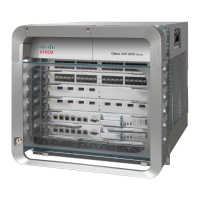19
Cisco ASR 9000 Series Aggregation Services Router Getting Started Guide
OL-28417-02
Introduction to the Cisco ASR 9000 Series Aggregation Services Router
Cisco ASR 9000 Series Router Overview
• Subscriber Interface (SINT) v6 Support—This features is an an aggregate interface, which is used
by all the subscriber IPv6 data packets punted on subscriber interfaces. For more information on
SINT, see the Cisco ASR 9000 Series Aggregation Services Router Broadband Network Gateway
Configuration Guide.
• BNG Packaging—This feature ensures that minimum system resources are used on systems that do
not use the BNG features.. For more information on how to implement the BNG packaging, see the
Cisco ASR 9000 Series Aggregation Services Router Broadband Network Gateway Configuration
Guide.
• Dual-Stack (DS) Lite—This feature enables a broadband service provider to share IPv4 addresses
among customers by combining two technologies: IP in IP (IPv4- in-IPv6) and Network Address
Translation (NAT). For more information on DS-Lite, see the Cisco ASR 9000 Series Aggregation
Services Router Broadband Network Gateway Configuration Guide.
• Excessive Punt Flow Trap—This feature allows to identify and mitigate control packet traffic from
remote devices that send control packets at a rate that greatly exceeds that of other devices. For more
information on excessive punt flow trap, see the Cisco ASR 9000 Series Aggregation Services Router
Broadband Network Gateway Configuration Guide.
• IPv6 Neighbor Discovery (ND)—This feature uses Internet Control Message Protocol (ICMP)
messages and solicited-node multicast addresses to determine the link-layer address of a neighbor
on the same network (local link), verify the reachability of a neighbor, and track neighboring routers.
For more information on ND, see the Cisco ASR 9000 Series Aggregation Services Router
Broadband Network Gateway Configuration Guide.
• Bidirectional Forwarding Detection (BFD) over GRE—This feature allows link failure to be
detected more rapidly than existing GRE. The BFD switching over GRE links works when the BFD
packets are transmitted from one end point node to the remote end point node. For more information
on BFD over GRE (BFDoGRE), see the Cisco ASR 9000 Series Aggregation Services Router
Routing Configuration Guide.
• Bidirectional Forwarding Detection (BFD) IPv6 Multihop—This feature enables IPv6 Multihop
BFD sessions where BFD neighbors can be multiple hops away either physically or logically, and
there is more than one path to reach the BFD neighbor. For more information on BFD IPv6
Multihop, see the Cisco ASR 9000 Series Aggregation Services Router Routing Configuration
Guide.
• Wide Metric Support for Enhanced Interior Gateway Routing Protocol (EIGRP)—This feature
providse metric values while redistributing a protocol into an EIGRP interface for a wide variety of
networks. For more information on wide metric support for EIGRP, see the Cisco ASR 9000 Series
Aggregation Services Router Routing Configuration Guide.
• Locator and ID Separation Protocol (LISP))—This is a network-based protocol designed to
implement separation of Internet addresses into Endpoint Identifiers (EIDs) and Routing Locators
(RLOCs). For more information on LISP, see the Cisco ASR 9000 Series Aggregation Services
Router Routing Configuration Guide.
• BGP-RIB Feedback Mechanism—This feature configures BGP to wait for feedback from RIB
indicating that the routes that BGP installed in RIB have been installed in FIB, before BGP send out
updates to neighbors. For information on how to implement BGP-RIB Feedback Mechanism, see the
Cisco ASR 9000 Series Aggregation Services Router Routing Configuration Guide.
• Stateful Network Address Translation (NAT) 64—This feature provides a translation mechanism
that translates IPv6 packets into IPv4 packets and vice versa. For more information on how to
impletement stateful NAT 64 mechanism, see the Cisco ASR 9000 Series Aggregation Services
Router CGv6 Configuration Guide.

